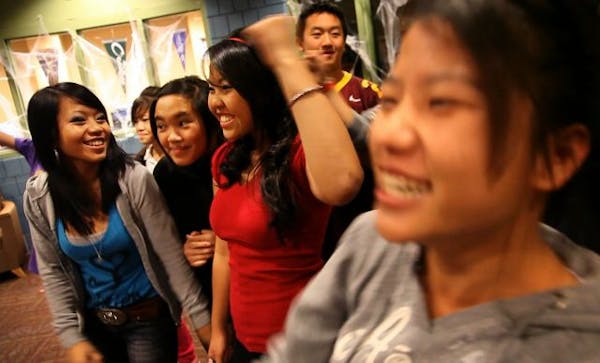It was a ritual for many young rock fans now in their 30s and 40s. And, boy, was it dumb.
Pink Floyd's "The Wall" somehow became the ultimate midnight movie in the '80s. You can probably guess what that entailed. If it wasn't showing at a movie theater whose operators tolerated patrons taking a really long time adding up their money at the popcorn counter, it would be showing at somebody's house whose parents were cool enough to buy a VCR -- but they also had to be clueless enough to let kids come over and watch a Pink Floyd movie late at night.
And talk about dumb: I'm still amazed to this day that the Como Planetarium, operated by the St. Paul School District, actually hosted Pink Floyd laser-light shows in the '80s. The district might as well have just come up with its own brand of rolling papers for fundraising.
To this day, though, the biggest example of idiocy surrounding "The Wall" is the idea that it was tailor-made for stoners. The original 1979 double-LP album of "The Wall" is actually a dark, depressing piece of work. Throw in Gerald Scarfe's animation and Bob Geldof's shaved eyebrows, and the 1982 movie was dark, depressed and creepy and disturbing.
Now that Roger Waters is restaging "The Wall" on an ambitious, surround-sound tour coming Wednesday to Xcel Energy Center in St. Paul, it's becoming clearer that Pink Floyd's visionary frontman wrote the songs based on his war-torn London childhood, the death of his father in the war, struggles with substance abuse, the dark side of touring and the demise of his marriage and his band. He is updating those themes on tour with examples of more recent scars of war.
Yeah, not exactly party-hardy material.
"Clearly, there was a reason that I thought of building a wall between me and the audience," Waters, 67, told Rolling Stone at the start of the tour, not showing any lighter feelings toward the album 31 years later. "At some subconscious level, I recognized how frightened I was."
Here's a comparison of how the half-baked stoner interpretations of "The Wall" compare with the dramatic version that Waters actually had in mind when he wrote the songs.
"The Happiest Days of Our Lives / Another Brick in the Wall, Part 2"
The single that would be Floyd's only No. 1 hit, it featured the wholesale mantra, "We don't need no education."
Stoner interpretation: Yeah, school sucks! Down with all teachers! I'm not going to be a pawn in your game, man!
Waters' version: "It's not meant to be a blanket condemnation of teachers everywhere, but the bad ones who can really do people in," he said in 1979. Parts of the song -- and especially its accompanying scenes in the movie -- also carry a message of learning to think for yourself and rise above the crowd. Which is actually a backhanded way of saying stay in school and do well.
"Comfortably Numb"
The album's musical high point (pun intended), Waters wrote the lyrics in a lowly state off a demo by guitarist David Gilmour.
Stoner interpretation: Waters found solace from all his misery in booze and drugs. Those distant ships smoking on the horizon? That has to be a reference to bongs.
Waters' version: The lyrics are based on a painful 1977 incident in which he had to be shot up with a tranquilizer for stomach cramps before taking the stage in Philadelphia. "That was the longest two hours of my life," he told Rolling Stone. Hardly sounds comfortable.
"Mother"
"Mother, do you think they'll drop the bomb?" Waters asks at the start of the song -- a song that teenage boys with acoustic guitars have been melodramatically echoing in bedrooms across the globe for three decades.
Stoner interpretation: The world is a big, scary place that's probably coming to an end soon, so tell Mom you love her. Not right now, though (see final line: "Mother did it need to be so high?").
Waters' version: The song is about "the idea that we can be controlled by our parents' views on things like sex," he told Mojo magazine. "The single mother of boys, particularly, can make sex harder than it needs to be." Yeesh, this might be the creepiest part of the album.
"Hey You"
Inexplicably left out of the movie, the song was to have been accompanied by scenes of the protagonist (Pink was his name) trying to claw his way out of his newly constructed wall.
Stoner interpretation: Dude, you're so wasted.
Waters' version: Whatever wall you're building -- be it medicinal, subconscious or whatever -- will isolate you from your friends and loved ones. And you might get so out-there, you'll write overwrought songs such as this one.
"Run Like Hell"
In various Floyd/Waters concerts, the hard-charging triumphal-type song is usually accompanied by loads of visual gimmickry such as lasers and the floating pig.
Stoner interpretation: Run! Those lasers and that pig are coming after you!
Waters' version: Fascist pigs are after you, not inflatable ones. So go read a newspaper and get in touch with the world's travesties instead of staring at the wall listening to Pink Floyd.
Chris Riemenschneider • 612-673-4658 • Follow him on Twitter: @ChrisRstrib
'THE WALL' TOUR -- BY THE NUMBERS
424: Bricks in the Wall, the tour's main attraction.
5 by 2 1/2 by 1 1/2 feet: The size of each brick.
230 feet: Length of the Wall.
35 feet, 6 inches: Height of the Wall.
14: Number of crew members it takes to build it.
5: Elevators behind the Wall for crew members to stack
bricks, each rising 30 feet.
66: Number of roadies in touring crew.
21: Number of trucks to transport the tour.
CHICAGO TRIBUNE

Minnesota Sports Hall of Fame: A class-by-class list of all members

This retired journalist changed professional wrestling from Mankato

